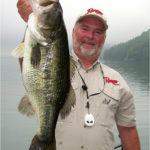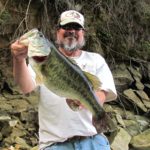
Cover a lot of water and keep your eyes peeled, and a Lake Jocassee monster might be in your future.
For more than 20 year Monty McGuffin of Westminster has been prowling the woods and waters of the Upstate and beyond as host of The Carolina Outdoorsman television Show. Most of his televised pursuits involve stalking fish, and one particular fish and one particular location have earned him the reputation as a trophy hunter: the oversized largemouth bass of Lake Jocassee.
“To look at it for the very first time, you probably wouldn’t figure Jocassee would hold some truly monstrous bass, but she does,” said McGuffin. “This lake is deep, cold and clear as a bell, exactly opposite of what you’d expect to be a trophy largemouth lake, but they’re in here — maybe not as many of them as what you’d find down in one of those swampy Florida lakes, but they’re here — and learning how to fish for them is just as different, too.”
McGuffin said it might be difficult to catch a trophy Jocassee largemouth, but the period just before and during the spring spawn, in his opinion, is certainly the easiest time to catch one. With depths of over 300 feet and water clarity that often provides visibility down to 25 feet, having Jocassee largemouth bass move up into depths of only 10 to 12 feet is a big help in locating the veritable needle in a haystack.
“Bass may start moving up as early as April 15, so long as we don’t have an extended spring cold spell,” McGuffin said. “When the water temperature starts bumping 58 degrees and that water temperature coincides with the full and new moon, then it starts getting right.”
This year, the new moon appears on April 29, with the full moon on May 14 and another new moon on May 28. It was on a similar lunar cycle a few years ago that McGuffin had his best day ever on Jocassee.
“We were shooting a show and pulled up on a blowdown tree, and I could see there were four bass holding just under it — three great big ones, and a smaller one” he said. “I wound up catching all four of those fish. The biggest weighed 10.33. I had nearly 30 pounds in just three fish, even the small one weighed 5 1/2 pounds.”
McGuffin is quick to point out that sight-fishing for trophy largemouth, just like calling in a big tom turkey, isn’t always that easy. The best way to fool a wary old bass, or even a small school of them, is to go against the grain when it comes to bait selection. The amount of fishing pressure the lake receives means a lot of bass see a lot of different lures; after a while, they learn to turn their noses up.
“I caught all those fish on a 10-inch tube bait, something I doubt they’d ever seen before. In fact, it was a tube bait in a rainbow trout color. By going against the grain, I got their attention and that helped me catch them. Then I put them all back to fight again one day,” he said.
Another thing McGuffin has learned over his years of fishing Jocassee is that unusually big fish can often be found in unusual water situations. Guiding a client interested in learning how to fish a jerkbait, McGuffin came across one isolated cut that was completely stained, something he’d never seen before — or since — on Jocassee.
“When you’re fishing a highlands reservoir and you find stained water, I don’t care what time or what day it is, you don’t pass it up,” said McGuffin. “I demonstrated by making eight casts. On the first cast I caught about a 4 ½-pound bass. I caught two more good fish a couple casts later, and on the last cast I caught an 8 ½-pounder.”
Sight-fishing in Jocassee’s clear water makes the game both easier and harder for the angler; the quarry can see just as well or better than the hunter. At times, that can change an angler’s gameplan.
“A lot of time, it’s running and gunning, looking at every blowdown tree or shallow ledge you can find,” he said. “But let’s say you happen to find a 12-pound bass laying next to a log, and she swirls one time at a bait, then won’t budge. I’ll commit the rest of the day to that fish. I think, ‘What if I gave up on her and moved on, then came in to the ramp that afternoon, and there’s three or four guys asking if I’d heard about that 12-pounder a guy caught over near Jumping Off Rock.’ To me, I can be like hunting a big buck. Once I know she’s there, all I want is that one bite.”
When Jocassee’s big girls want to dance, most fishermen aren’t afraid to travel. Even biologists are not immune to their piscatorial siren song. Ron Ahle of Columbia, who oversees the behind-the-scenes fisheries management for the S.C. Department of Natural Resources at Lake Murray, frequently spends his days off traveling to the Upstate to fill his dance card on Lake Jocassee.
“With Jocassee, wherever those streams and creeks come in, the water depth drops real fast,” Ahle said. “Those are probably not the best places to fish. Look for areas where the slope going into the water is more gentle. Those are the areas where you’re going to have better expanses of shallow water, better spawning areas for bass.”
Like McGuffin, Ahle plays a game of run-and-gun, sight-fishing by checking as many places that look like they might hold spawning bass.
“If you’ve got a small cove or pocket that might distribute a little bit of a delta out from where it comes out, those can be some really good places,” he said. “For me, it’s basically a game of just working the shorelines and looking at visible cover and getting out of the wind.”
Ahle said he finds decent fishable spots all over the lake.
“Let me just say, to put it into perspective, there’s nowhere on that lake that doesn’t provide possible habitat for fish,” Ahle said. “I mean, it’s almost anywhere you go, in any direction — on the main lake, up the tributaries — it’s really more about finding the right places in the area you’re in.”
Though Ahle, like most fishermen, relies on his electronics to check water depth and temperature, the Jocassee spawn is one place where human eyes have it over electronic eyes.
“It’s all sight-fishing,” he said. “I’m going to get up in the front of the boat and look anywhere from a couple of feet all the way out to 15 or 20 feet. You can still see the bottom pretty clearly at 15 feet.
“Here’s the other thing. Look just beyond your visibility. A lot of times you can see visible structure like a laid-down tree or stump, even if you can’t see the fish. This time of year, there’s about a 90-percent chance there’s a fish on that just out-of-sight structure. It just might be the big one.”
DESTINATION INFORMATION
HOW TO GET THERE — Four public-access ramps serve Lake Jocassee, all within the perimeter of Devil’s Fork State Park. To get to the park, travel on SC 11 north from Walhalla or south from Cleveland. Jocassee Lake Road intersects SC 11 near the midway point between the Lake Keowee Bridge and SC 130. Turn north and follow Jocassee Dam Road, which runs into the state park.
BEST TACTICS — From mid-April to the end of May, when THE water temperature reaches a steady 58 degrees, largemouth bass enter a spawning pattern on Lake Jocassee The best fishing occurs around the new moon and full moon. Bass will stage or hold on and around visible structure in water depths from two to 25 feet. The clear water makes sight-fishing for bedding bass possible. Anglers should strive to maintain distance from the fish to avoid spooking and cast a variety of topwater, suspending or soft-plastic baits to the fish to elicit a strike. Good fishing can be anywhere around the lake, but small cuts, coves and ledges with gradual slopes typically offer better fish-attracting structure than stream tributaries, which can be deeper and colder than preferred by the fish.
UPRIVER REQUIREMENTS — Two of Lake Jocassee’s major tributaries, the Toxaway and Horsepasture rivers, have headwaters across the border in North Carolina. No reciprocal license agreement exists between the two states. The border is marked, and you must have a North Carolina fishing license to fish upstream of the markers. A South Carolina license is required for all portions of the lake inside South Carolina lines.
GUIDES/FISHING INFO — Monty McGuffin, Carolina Outdoorsman Guide Service, 864-647-7410, www.cotvshow.com. See Guides and Charters in Classifieds.
ACCOMMODATIONS — Walhalla Motel, Walhalla, 864-638-2585, www.walhallamotelsc.com. Camping is available at Devils Fork State Park, 864-944-2639 or 866-345-7275, http://www.southcarolinaparks.com/devilsfork/camping.aspx.
MAPS — Navionics Electronic Charts, 800-848-5896, www.navionics.com; Delorme South Carolina Atlas & Gazetteer, 800-561-5105; www.delorme.com; Fishing Hot Spots, 800-ALLMAPS, www.fishinghotspots.com; Kingfisher Maps, 800-326-0257, www.kingfishermaps.com.







Be the first to comment